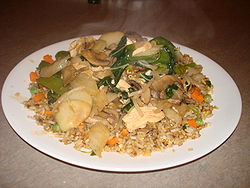
Chop suey
Encyclopedia
Chop suey is a Chinese dish
consisting of meat (often chicken, fish, beef, shrimp (UK: prawns) or pork) and eggs, cooked quickly with vegetables such as bean sprouts
, cabbage
, and celery
and bound in a starch-thickened sauce. It is typically served with rice but can become the Chinese-American form of chow mein
with the addition of stir-fried noodles.
Chop suey has become a prominent part of American Chinese cuisine
, Filipino cuisine, Canadian Chinese cuisine
, Indian Chinese cuisine
, and Polynesian cuisine. In Indonesian Chinese cuisine it is known as Cap cai
(雜菜, "mixed vegetables") and mainly consists of vegetables.

 Chop suey is widely believed to have been invented in America by Chinese
Chop suey is widely believed to have been invented in America by Chinese
immigrants, but in fact comes from Taishan
(Toisan), a district of Guangdong Province (Canton), which was the home of many of the early Chinese immigrants to the U.S. The Hong Kong doctor Li Shu-fan reported that he knew it in Taishan in the 1890s.
Chop suey appears in a 1884 article in the Brooklyn Eagle, by Wong Chin Foo
, "Chinese Cooking," which he says "may justly be called the "national dish of China." An 1888 description calls it "A staple dish for the Chinese gourmand is chow chop svey [sic], a mixture of chickens' livers and gizzards, fungi, bamboo buds, pigs' tripe, and bean sprouts stewed with spices." In 1898, it is described as "A Hash of Pork, with Celery, Onions, Bean Sprouts, etc."
Despite its Taishan (Toisan) background, there are various colorful stories about its origin, which Davidson (1999) characterizes as "culinary mythology": Some say it was invented by Chinese
immigrant cooks working on the United States
transcontinental railroad
in the 19th century. Another story is that it was invented during Qing Dynasty
premier Li Hongzhang
's visit to the United States in 1896 by his chef, who tried to create a dish suitable for both Chinese and American palates. Yet another is that, in the 1860's, a Chinese restaurant cook in San Francisco was forced to serve something to drunken miners after hours, when he had no fresh food. To avoid a beating, the cook threw leftovers in a wok and served the miners who loved it and asked what dish is this--he replied Chopped Sui. There is no good evidence for any of these stories.
Outside of Taishan (Toisan), the name "chop suey" or "shap sui in Cantonese, and "za sui", when used in Mandarin, has the somewhat different meaning of cooked animal offal or entrails. For example, in the classic novel Journey to the West
(circa 1590), Sun Wukong
tells a lion
-monster
in chapter 75: "When I passed through Guangzhou
, I bought a pot for cooking za sui - so I'll savour your liver, entrails, and lungs." This may be the same as the "Chop Suey Kiang" found in 1898 New York.
During his exile in the United States, Liang Qichao
, a Guangdong
(Canton) native, wrote in 1903 that there existed in the United States a food item called chop suey which was popularly served by Chinese restaurateurs, but which local Chinese people did not eat. The term "za sui" (杂碎) is found in newer Chinese-English dictionaries with both meanings listed: cooked entrails, and chop suey in the Western sense.
Chinese cuisine
Chinese cuisine is any of several styles originating in the regions of China, some of which have become highly popular in other parts of the world – from Asia to the Americas, Australia, Western Europe and Southern Africa...
consisting of meat (often chicken, fish, beef, shrimp (UK: prawns) or pork) and eggs, cooked quickly with vegetables such as bean sprouts
Mung bean
The mung bean is the seed of Vigna radiata. It is native to the Indian subcontinent.-Description:They are small, ovoid in shape, and green in color...
, cabbage
Cabbage
Cabbage is a popular cultivar of the species Brassica oleracea Linne of the Family Brassicaceae and is a leafy green vegetable...
, and celery
Celery
Apium graveolens is a plant species in the family Apiaceae commonly known as celery or celeriac , depending on whether the petioles or roots are eaten: celery refers to the former and celeriac to the latter. Apium graveolens grows to 1 m tall...
and bound in a starch-thickened sauce. It is typically served with rice but can become the Chinese-American form of chow mein
Chow mein
Chow mein is a Chinese term for a dish of stir-fried noodles, of which there are many varieties.-Etymology:...
with the addition of stir-fried noodles.
Chop suey has become a prominent part of American Chinese cuisine
American Chinese cuisine
American Chinese cuisine refers to the style of food served by many Chinese restaurants in the United States. This type of cooking typically caters to Western tastes, and differs significantly from the original Chinese cuisine.-History:...
, Filipino cuisine, Canadian Chinese cuisine
Canadian Chinese cuisine
Canadian Chinese cuisine is a popular style of cooking exclusive to take-out and dine-in eateries found across Canada. It was the first form of commercially available Chinese food available in Canada. This cooking style was invented by early Cantonese immigrants who adapted traditional Chinese...
, Indian Chinese cuisine
Indian Chinese cuisine
Indian Chinese cuisine is the adaptation of Chinese seasoning and cooking techniques to Indian tastes. It is said to have been developed by the small Chinese community that has lived in Kolkata for over a century...
, and Polynesian cuisine. In Indonesian Chinese cuisine it is known as Cap cai
Cap cai
Cap cai sometimes spelled Cap cay is Hokkien-derived term of a popular Chinese Indonesian stir fried vegetable dish that originates from Fujian cuisine....
(雜菜, "mixed vegetables") and mainly consists of vegetables.
Origin


Chinese American
Chinese Americans represent Americans of Chinese descent. Chinese Americans constitute one group of overseas Chinese and also a subgroup of East Asian Americans, which is further a subgroup of Asian Americans...
immigrants, but in fact comes from Taishan
Taishan
Taishan is a coastal county-level city in Guangdong Province, China. The city is part of the Greater Taishan Region....
(Toisan), a district of Guangdong Province (Canton), which was the home of many of the early Chinese immigrants to the U.S. The Hong Kong doctor Li Shu-fan reported that he knew it in Taishan in the 1890s.
Chop suey appears in a 1884 article in the Brooklyn Eagle, by Wong Chin Foo
Wong Chin Foo
Wong Chin Foo was a Chinese-born journalist, lecturer, and writer, one of the most prolific Chinese writers in the San Francisco press of the 19th century...
, "Chinese Cooking," which he says "may justly be called the "national dish of China." An 1888 description calls it "A staple dish for the Chinese gourmand is chow chop svey [sic], a mixture of chickens' livers and gizzards, fungi, bamboo buds, pigs' tripe, and bean sprouts stewed with spices." In 1898, it is described as "A Hash of Pork, with Celery, Onions, Bean Sprouts, etc."
Despite its Taishan (Toisan) background, there are various colorful stories about its origin, which Davidson (1999) characterizes as "culinary mythology": Some say it was invented by Chinese
Chinese American
Chinese Americans represent Americans of Chinese descent. Chinese Americans constitute one group of overseas Chinese and also a subgroup of East Asian Americans, which is further a subgroup of Asian Americans...
immigrant cooks working on the United States
United States
The United States of America is a federal constitutional republic comprising fifty states and a federal district...
transcontinental railroad
Transcontinental railroad
A transcontinental railroad is a contiguous network of railroad trackage that crosses a continental land mass with terminals at different oceans or continental borders. Such networks can be via the tracks of either a single railroad, or over those owned or controlled by multiple railway companies...
in the 19th century. Another story is that it was invented during Qing Dynasty
Qing Dynasty
The Qing Dynasty was the last dynasty of China, ruling from 1644 to 1912 with a brief, abortive restoration in 1917. It was preceded by the Ming Dynasty and followed by the Republic of China....
premier Li Hongzhang
Li Hongzhang
Li Hongzhang or Li Hung-chang , Marquis Suyi of the First Class , GCVO, was a leading statesman of the late Qing Empire...
's visit to the United States in 1896 by his chef, who tried to create a dish suitable for both Chinese and American palates. Yet another is that, in the 1860's, a Chinese restaurant cook in San Francisco was forced to serve something to drunken miners after hours, when he had no fresh food. To avoid a beating, the cook threw leftovers in a wok and served the miners who loved it and asked what dish is this--he replied Chopped Sui. There is no good evidence for any of these stories.
Outside of Taishan (Toisan), the name "chop suey" or "shap sui in Cantonese, and "za sui", when used in Mandarin, has the somewhat different meaning of cooked animal offal or entrails. For example, in the classic novel Journey to the West
Journey to the West
Journey to the West is one of the Four Great Classical Novels of Chinese literature. It was written by Wu Cheng'en in the 16th century. In English-speaking countries, the tale is also often known simply as Monkey. This was one title used for a popular, abridged translation by Arthur Waley...
(circa 1590), Sun Wukong
Sun Wukong
Sun Wukong , also known as the Monkey King is a main character in the classical Chinese epic novel Journey to the West . In the novel, he is a monkey born from a stone who acquires supernatural powers through Taoist practices...
tells a lion
Lion
The lion is one of the four big cats in the genus Panthera, and a member of the family Felidae. With some males exceeding 250 kg in weight, it is the second-largest living cat after the tiger...
-monster
Monster
A monster is any fictional creature, usually found in legends or horror fiction, that is somewhat hideous and may produce physical harm or mental fear by either its appearance or its actions...
in chapter 75: "When I passed through Guangzhou
Guangzhou
Guangzhou , known historically as Canton or Kwangchow, is the capital and largest city of the Guangdong province in the People's Republic of China. Located in southern China on the Pearl River, about north-northwest of Hong Kong, Guangzhou is a key national transportation hub and trading port...
, I bought a pot for cooking za sui - so I'll savour your liver, entrails, and lungs." This may be the same as the "Chop Suey Kiang" found in 1898 New York.
During his exile in the United States, Liang Qichao
Liang Qichao
Liang Qichao |Styled]] Zhuoru, ; Pseudonym: Rengong) was a Chinese scholar, journalist, philosopher and reformist during the Qing Dynasty , who inspired Chinese scholars with his writings and reform movements...
, a Guangdong
Guangdong
Guangdong is a province on the South China Sea coast of the People's Republic of China. The province was previously often written with the alternative English name Kwangtung Province...
(Canton) native, wrote in 1903 that there existed in the United States a food item called chop suey which was popularly served by Chinese restaurateurs, but which local Chinese people did not eat. The term "za sui" (杂碎) is found in newer Chinese-English dictionaries with both meanings listed: cooked entrails, and chop suey in the Western sense.

